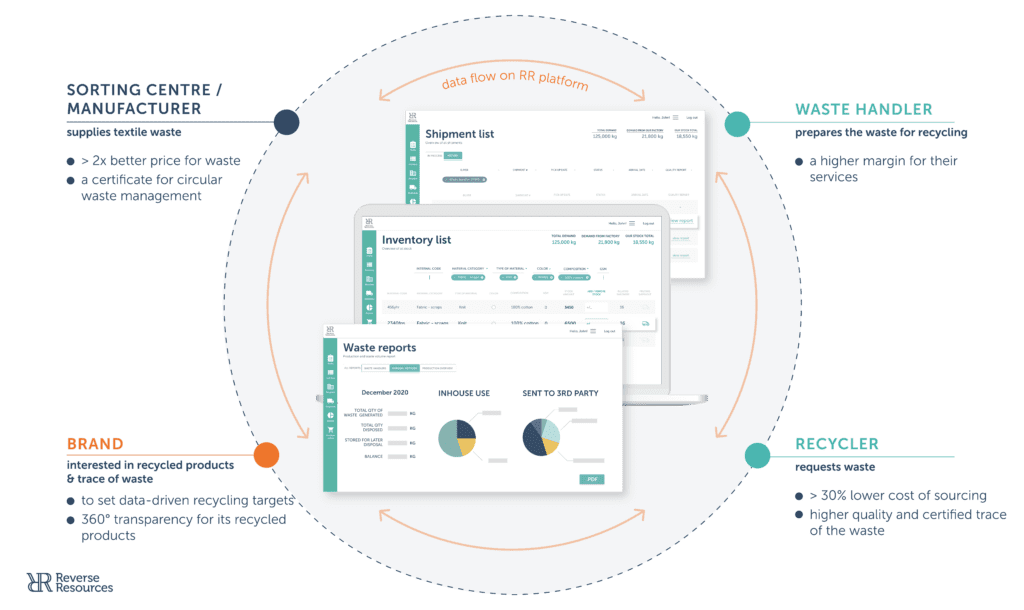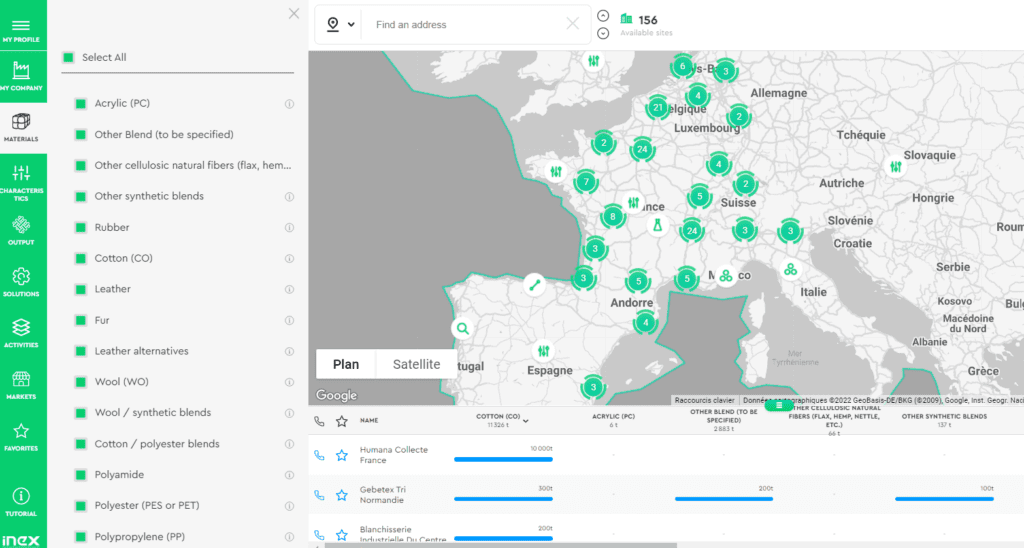Sorting For Circularity Europe: An Evaluation And Commercial Assessment Of Textile Waste Across Europe
Linking Supply And Demand Through Digital Platforms
Phase 2
Currently, there is no widely adopted tool that can match the supply, the sorters, to the demand, the textile recyclers and material reprocessors. Hence, creating a transparent system where stakeholders in the industry can connect to supply of textile flows that can feed into recycling is required. To enable the link between sorters and recyclers, there is a need for a platform that is open-source and accessible, while providing transparency on the location and flow of PCT across the value chain. This visibility is crucial in order to not only understand current end-of-use infrastructure and its gaps, but also to envision a new circular system for textile sorting and recycling infrastructure.
Phase 2 of the Sorting for Circularity Europe project, started by conducting a landscape analysis of existing platforms within and outside the fashion industry. Within the fashion and textiles industry, some existing platforms include Reverse Resources, Refashion Recycle, Circular.fashion, and Excess Materials Exchange. From this landscape analysis, two types of platforms emerged:
First, an information-based digital platform that provides visibility into volumes and locations of waste flows, along with key contacts from sorting and recycling organisations. This type of platform addresses the fundamental challenge around the lack of transparency in the industry and presents a low entry barrier for users, as there is no obligation to share confidential information. However, this type of platform leads to a potential duplication of efforts as this model is seen in various iterations in the market. Moreover, it requires additional effort to facilitate business models outside of the platform, instead of a fully digitised process.
Second, a transaction-based digital platform, which is an end-to-end marketplace that matches supply of PCT from sorting partners to the recycler’s demand. It provides capabilities and information required for complete business-to-business (B2B) transactions. This type of platform addresses challenges around post-consumer textiles flow data transparency between business partners and standardisation, accelerates the flow of waste into the appropriate end-of-use scenario, and simplifies the implementation of circular business models for sorters and recyclers. However, a transaction-based digital platform requires buy-in from users for commercial and confidential data. Also, due to the infancy of digital platforms in the PCT space, scaling such platforms requires multiple partnerships and additional financing.
To evaluate the product-market fit of these two types of platforms, sorters were interviewed to understand potential benefits and challenges in using digital platforms, and functionalities required to efficiently operate and use the platform. The interviews concluded that in the short-term, onboarding sorters and collectors to an information-based platform is more realistic, in the hope that it will transition to a transaction-based system once demand for recycling feedstock increases. The sorters highlighted that an information-based platform is attractive as it enables them to access new markets and customers for feedstock that was previously not valorised. The sorters identified specific needs for the platform such as 1) filtering capabilities (i.e. per location, volume, or composition), 2) accurate contact information for offline transactions, 3) recycler’s to include clear description of their operations, and type and quantity of product required, 4) multilingual systems, and 5) low administrative efforts and ease of use. Barriers that sorters face in implementing digital platforms relate to the lack of standardisation in the sorting process that influences output requirements, undefined business case for the recycling fractions (addressed in Section 1.4), low demand from recyclers as the industry relies on long-term business contracts, and confidentiality of pricing and customer information.
Based on the landscape analysis and interviews with sorters, this project aims to amplify two platforms: Reverse Resources and Refashion Recycle. Reverse Resources is an open-access matchmaking, supply chain management and traceability platform for textiles. The platform allows a large network of collectors, sorters as well as textile manufacturers and service providers to securely collaborate in making joint offers of textiles by type and composition to the emerging large textile-to-textile recyclers, verify where, how and whose waste is getting recycled, and provide real-time data and market insight for the industry to support scaling up fibre circulation.

Image 6: Reverse Resources digital platform (Source: Reverse Resources)
Refashion, the French accredited Extended Producer Responsibility eco-organisation, has developed the Recycle platform, a digital waste mapping and matchmaking tool focusing on post-consumer household textile waste. It provides detailed overviews on non-reusable textiles and footwear feedstock, recycling solutions and key stakeholder profiles throughout the European textiles recycling value chain. With its cross-industrial approach opening up end markets beyond textile-to-textile recycling, Recycle by Refashion provides a stepping stone to accelerate the industrialisation of recycling solutions in Europe. This project facilitated the introduction between Reverse Resources and Refashion Recycle to the six European sorters involved. Reverse Resources have 39 active recyclers and 32 active waste handlers/ sorters on their platform, while Refashion Recycle have 103 recyclers and 66 sorters onboarded onto their platform. This represents a large portion of the European circularity industry.

Image 7: Refashion Recycle digital platform (Source: Refashion)
